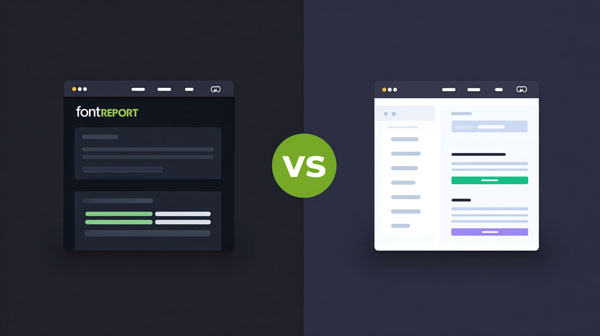
The call comes in on a Tuesday afternoon. Your client's legal team forwarded a cease and desist letter from a font foundry. The website you launched eight months ago uses fonts without proper web licences. The foundry wants $50,000 to settle.
Your contract says the client is responsible for font licensing. The client's lawyer says your agency implemented the fonts, so you're liable. Now you're scheduling calls with your own lawyer to figure out who actually pays.
This isn't a hypothetical scenario. Font licensing disputes create genuine liability questions for agencies every year, and the answers aren't always clear-cut.
Important note: This article provides general information about font licensing practices and is not legal advice. For specific guidance about your situation, consult with a lawyer who specialises in intellectual property or contract law.
What Most Font Licence Agreements Actually Say
Most font End User Licence Agreements specify that the licence holder is whoever purchased the font. Straightforward enough - until you start working on client projects.
If a client needs a font for their project, they typically must purchase their own licence. Your agency's font licences generally don't transfer to clients unless the EULA explicitly permits it.
Many designers work around this by converting fonts to outlines in programs like Adobe Illustrator and providing vectorised versions rather than actual font files. This works for logos and static designs, but doesn't solve the problem for websites, ongoing marketing materials, or situations where the client needs editable text.
The Messy Reality: Who's Actually Liable?
Font licensing violations can potentially implicate multiple parties:
The client uses the font publicly on their website, marketing materials, or products. The font foundry sees the client's use and sends them the cease and desist letter.
The agency implemented the fonts, uploaded them to the website, and delivered the finished work. If you didn't verify proper licensing, did you contribute to the infringement?
Individual designers can get pursued by foundries when they've implemented fonts improperly.
From a practical standpoint, clients typically bear ultimate responsibility for fonts used in their business. But agencies aren't completely protected if they actively installed unlicensed fonts or ignored obvious red flags.
According to Pressable's guide for WordPress agencies, most font EULAs define the "user" as the party implementing the software. In agency projects, that's usually the agency, not the client. Even if your contract shifts responsibility to the client, copyright holders can still pursue you for infringement.
Three Common Liability Scenarios
Scenario 1: Agency Uses Their Own Fonts
Your agency has a desktop licence for a font. You use it to design a client's website mockups, then upload those fonts to their live site.
Problem: Your desktop licence doesn't cover web use or allow you to install fonts on the client's server. You've violated your own licence agreement. For more details on why desktop and web licences differ, see our complete guide to desktop vs web font licences.
Who's liable: Potentially both you and the client. You violated your licence terms, and the client is publicly using fonts without proper authorisation.
Prevention: Purchase web font licences in the client's name. The website owner should be the end-user of the licence. Be especially careful with logo work - many fonts prohibit logo use or require upgraded licensing.
Scenario 2: Client Provides the Fonts
Your client emails their brand fonts and asks you to use them on their new website. You assume they have proper licensing.
Problem: The client might only have desktop licences, not web licences. Or they might be using "free for personal use" fonts commercially. Or their licence might explicitly prohibit sharing font files with contractors.
Who's liable: Primarily the client, since they provided the fonts. But you could face claims if you failed to verify licensing as part of your due diligence.
Prevention: Always ask clients to provide proof of licensing that specifically covers the use case you're implementing. If they can't produce it, flag the issue and include font licensing in your project scope.
Scenario 3: Theme Bundles Fonts
You purchase a WordPress theme that includes beautiful fonts. You use it for a client site, assuming the theme licence covers everything.
Problem: Some themes bundle fonts improperly – either without proper authorisation or with licences that don't transfer to your client. The client's website might be violating font licensing without anyone realising it.
Who's liable: Technically the website owner (your client). But you recommended and implemented the theme, which creates client relationship issues even if you're not legally liable.
Prevention: Research theme font licensing before purchasing. When in doubt, replace bundled commercial fonts with properly licensed alternatives or open source options. Read more about hidden WordPress font licensing issues.
What to Include in Your Agency Contracts
While we can't provide legal advice, here are common provisions agencies include regarding font licensing. Have your lawyer review and customise these for your specific situation:
Font licensing responsibility: Specify whether your agency or the client will purchase necessary font licences. Example: "Client agrees to purchase all necessary font licences for fonts selected during the design process. Agency will provide guidance on licensing requirements but is not responsible for obtaining licences."
Font audit provision: "Agency will conduct a font licensing audit before project launch and provide Client with a list of fonts requiring licences. Client is responsible for purchasing and maintaining these licences."
Deliverables specification: Clearly state what you will and won't provide. Example: "Agency will deliver outlined/vectorised versions of logo designs. Agency will not provide original font files to Client."
Ongoing maintenance: If you're providing long-term maintenance, specify who monitors licence compliance and subscription renewals.
Practical Steps to Protect Your Agency
Make Licensing Part of Your Workflow
Build font licensing into your standard process:
- During design: Track which fonts you're using and verify licensing before presenting to clients
- In proposals: Include font licensing as a line item or explicitly note who's responsible for purchasing
- Before launch: Conduct a final audit to verify all fonts are properly licensed and delete any trial or demo fonts
- At handoff: Provide clients with a complete list of fonts in use and licensing requirements
Use Open Source to Reduce Risk
Open source fonts eliminate most licensing headaches. Fonts under the SIL Open Font Licence or Apache Licence can be used freely for commercial projects with no ongoing licence management needed.
They also solve GDPR concerns associated with externally hosted fonts. When you host fonts on the client's own server, there's no third-party data exposure. Check out our complete guide to free fonts for commercial use for options.
Document Everything
Keep copies of purchase receipts, EULAs, and licence limits in your internal asset register. This protects you during audits and handovers. If a licensing question arises years later, you want proof of what was discussed and agreed upon.
Include Licensing in Client Communications
When presenting font options, include licensing costs upfront. This prevents surprises later and gives clients time to budget appropriately or choose open source alternatives.
If Something Goes Wrong
Despite your best efforts, licensing issues sometimes surface after project completion. If a client receives a cease and desist letter:
Don't panic: Most foundries work with you to reconcile the situation rather than immediately pursuing legal action
Review your contract: What did your agreement say about font licensing responsibility?
Gather documentation: Pull together all emails, proposals, and records related to font selection and licensing
Communicate with the client: Be honest about what happened and work together to resolve it
Contact the foundry: Often the most cost-effective solution is purchasing the proper licence retroactively
Consult your lawyer: If there's any question about liability or if the claim is substantial, get legal counsel immediately
Companies have paid substantial settlements for font licensing mistakes, so addressing these issues promptly matters. For examples of costly violations, see our article on font licensing mistakes that cost companies thousands.
The Bottom Line
Font licensing liability isn't always clear-cut. While clients typically bear ultimate responsibility for fonts used in their business, agencies can face claims if they implement fonts without proper due diligence.
The best protection is clear contracts, thorough documentation, and building font licensing verification into your standard process. It takes 15 minutes per project to check licensing properly – far less time than dealing with a cease and desist letter later.
Not sure which fonts are currently on your client websites or whether they're properly licensed? Scan any website with FontReport to get an instant breakdown of every font in use and identify potential licensing issues before they become legal problems.

